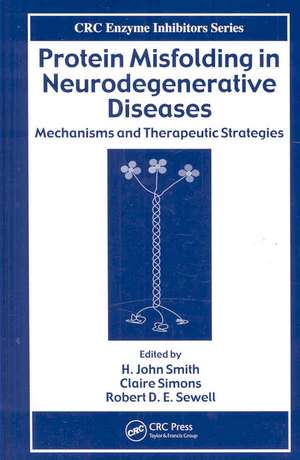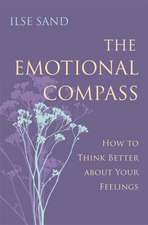Protein Misfolding in Neurodegenerative Diseases: Mechanisms and Therapeutic Strategies
Editat de Robert D. E. Sewellen Limba Engleză Hardback – 3 dec 2007
A Comprehensive Multifaceted Examination of the Complex Causal Agents Implicated in Protein Misfolding
Divided into five sections, this groundbreaking text provides up-to-date accounts for Alzheimer’s, Parkinson’s, Huntington’s, Amyotrophic Lateral Sclerosis and Transmissible Spongiform Encephalitis. It also explores the highly likelihood that multiple factors, including oxidative stress, play a role in these complex diseases.
| Toate formatele și edițiile | Preț | Express |
|---|---|---|
| Paperback (1) | 512.67 lei 6-8 săpt. | |
| CRC Press – 18 oct 2019 | 512.67 lei 6-8 săpt. | |
| Hardback (1) | 1561.38 lei 6-8 săpt. | |
| CRC Press – 3 dec 2007 | 1561.38 lei 6-8 săpt. |
Preț: 1561.38 lei
Preț vechi: 1904.12 lei
-18% Nou
Puncte Express: 2342
Preț estimativ în valută:
298.81€ • 310.81$ • 246.68£
298.81€ • 310.81$ • 246.68£
Carte tipărită la comandă
Livrare economică 14-28 aprilie
Preluare comenzi: 021 569.72.76
Specificații
ISBN-13: 9780849373107
ISBN-10: 0849373107
Pagini: 596
Ilustrații: 7 Halftones, black and white; 18 Tables, black and white; 80 Illustrations, black and white
Dimensiuni: 156 x 234 x 32 mm
Greutate: 0.93 kg
Ediția:1
Editura: CRC Press
Colecția CRC Press
ISBN-10: 0849373107
Pagini: 596
Ilustrații: 7 Halftones, black and white; 18 Tables, black and white; 80 Illustrations, black and white
Dimensiuni: 156 x 234 x 32 mm
Greutate: 0.93 kg
Ediția:1
Editura: CRC Press
Colecția CRC Press
Public țintă
Academic and Professional Practice & DevelopmentCuprins
INTRODUCTION. Protein Folding. ALZHEIMER’S DISEASE. Alzheimer’s Disease: Epidemiology, symptoms and clinical pathology. Improving Cholinergic Transmission. Reduction in Plaque Formation. Carbonic Anhydrase Activation. Reduction of Intracellular Neurofibrillary Tangles from Tau Protein. Oxidative Stress Reduction. Enhancement of Brain Retinoic Acid Levels. Sulfatase Inhibitors and Cognitive Enchancement. PARKINSON’S DISEASE. Epidemiology, Symptoms and Clinical Pathology. Restoring Dopamine Levels. Anticholinergics. RARER NEURODEGENERATIVE DISEASES. Huntington’s Disease. Amyotrophic Lateral Sclerosis (Motor Neurone Disease). Transmissible Spongiform Encephalopathies (TSEs) – Bovine Spongiform Encephalopathy (BSE) – Creutzfeldt-Jacob Disease (CJD, vCJD) – Scrapie. Overview – Common Role of Protein Misfolding in Neurodegenerative Diseases.
Notă biografică
H. John Smith, Claire Simons, Robert D. E. Sewell
Descriere
Current research suggests that neurodegenerative diseases such as Alzheimer’s, Parkinson’s, Huntington’s, and Creutzfeldt-Jacob may be linked to disorders in protein shape referred to as protein misfolding. Continued study in this area could lead to promising advances in future treatment of these diseases. This groundbreaking text describes the latest findings regarding protein misfolding in the context of it being a marker, and perhaps a cause, in neurodegenerative diseases. Comprehensive coverage includes the diverse biochemical targets/markers for each disease, the currently limited success of drug therapies, and the cutting-edge research that could lead to more promising treatments.











